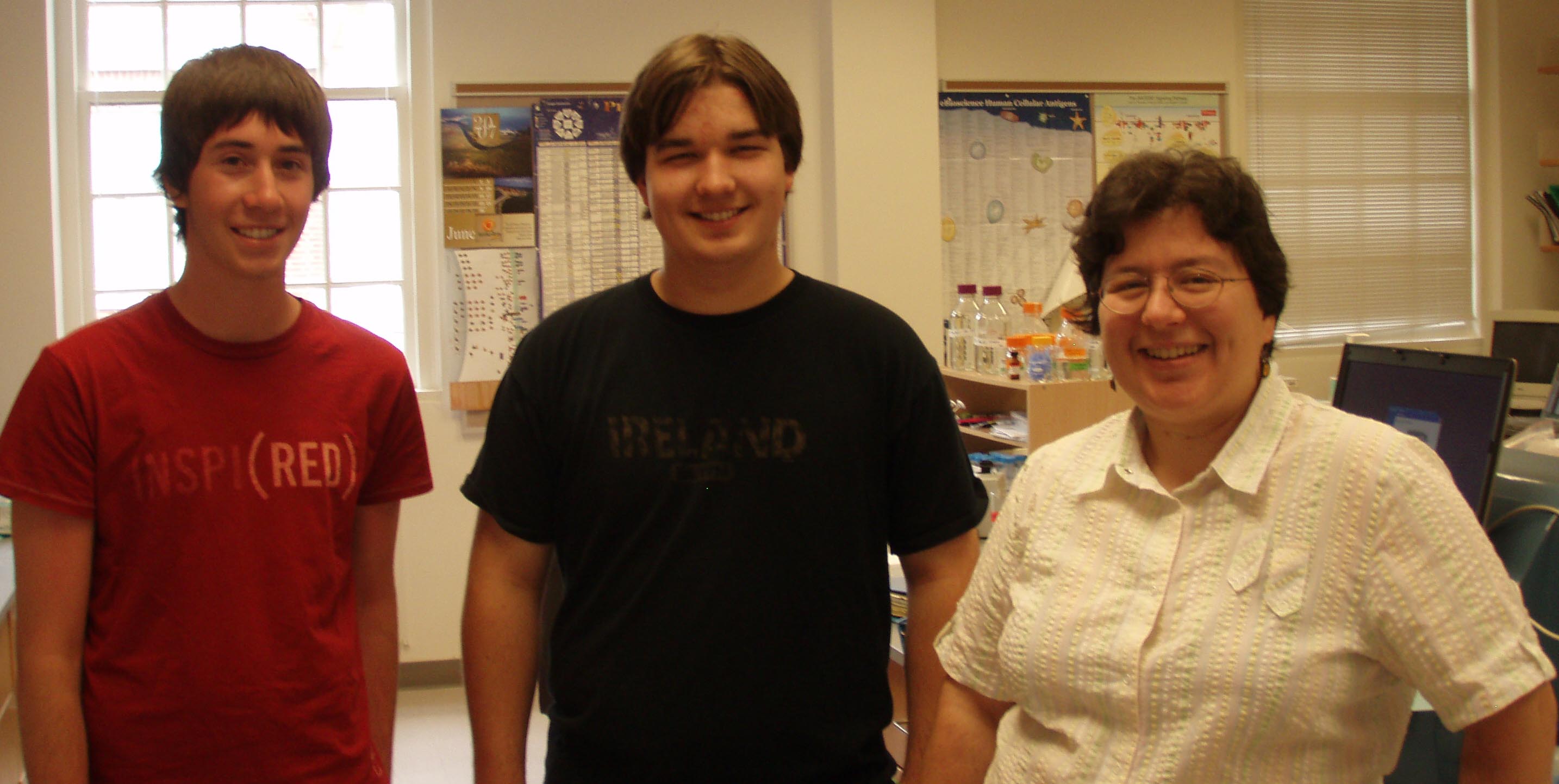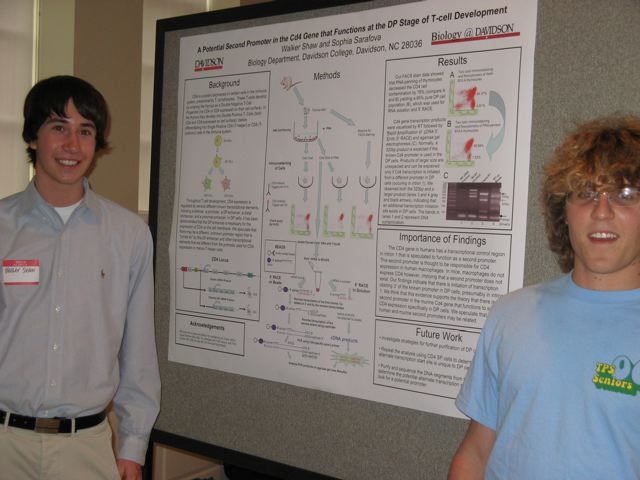
Sarafova Lab

Summer 2007 members - Walker Shaw '10 and Matthew Surdel '10
Projects
Identifying a CD4 cell-specific transcription factor that binds to the Cd4 promoter
During T cell development in the thymus, CD4-helper and CD8-killer T cells arise from a common thymocyte precursor. Cd4 gene expression is essential for the development of CD4-helper T cells and for their subsequent ability to mount an effective immune response to foreign antigens. At the same time, Cd4 expression is extinguished on thymocytes that develop into CD8-killer T cells. This complex pattern of Cd4 regulation is primarily controlled by the activity of the Cd4 silencer, a cis-regulatory element for Cd4 expression, that silences Cd4 expression in CD8-killer T cells. In the absence of the CD4 silencer, CD4 is inappropriately expressed in CD8-killer cells, and it never reaches the high level of CD4 expression normally present on CD4-helper cells. This indicates that there are additional differences in regulation of Cd4 expression between CD4 and CD8 cells that may elucidate how “killer” vs. “helper” transcriptional regulatory programs are established and maintained. In previous studies, a Cd4 promoter binding activity was observed that was present in nuclear extracts of CD4 cells but not CD8 cells, implying that a CD4 cell-specific transcription factor exists. This observation could explain the difference in Cd4 gene expression in the two T cell types. In this project, we will attempt to purify and identify this potential candidate transcription factor using a biochemical approach. Nuclear extracts from CD4 and CD8 T cells will be made. After an initial enrichment of DNA-binding proteins by column chromatography, oligo-precipitation will be performed using the wild type vs. mutant binding sequence from the Cd4 promoter. The molecular weight of the unique protein(s) present in the CD4 cell nuclear extract will be identified by SDS-PAGE and silver staining. In collaboration with the Chemistry department, further characterization and identification of the protein(s) can be done by tandem mass spectrometry.
Progress: We have partially purified proteins with a binding activity specific for the Cd4 promoter sequence and are now in the process of identifying them. For details see Matt Surdel's poster
Matthew Surdel '10 presenting her poster to Dr. Greta Munger at the 2009 Science and Math Symposium
Does Cd4 transcription differ in the immature (developing) versus mature CD4-helper T cells?
CD4 is a protein expressed on certain cells in the immune system, predominantly T- lymphocytes. These T-cells develop by entering the thymus as a Double Negative T-Cell Progenitor (no CD4 or CD8 expressed on their cell surface). In the thymus, they develop into Double Positive T- Cells (both CD4 and CD8 expressed on cell surface) before differentiating into Single Positive CD4 (T-helper) or CD8 (T-cytotoxic) cells in the immune system. Throughout T-cell development, CD4 expression is regulated by several different known transcriptional elements, including a silencer, a promoter, a DP enhancer, a distal enchancer, and a proximal enhancer. In addition, a second promoter for CD4 has been identified in humans and is proposed to be responsiblle for CD4 expression in macrophages and some dendritic cells, but its function during T cell development has not been investigated so far. In mice, it has been demonstrated that there is a positive transcriptional element in the first intron, deleted the two CD4 silencer knockout mice (Zou 2001, Rahemtula 2001). This positive transcriptional element could be another enhancer that functions at the DP stage or a second promoter that may be “turned on” by the known DP enhancer, explaining the difference in CD4 expression in immature DP vs. mature T-helper cells in the mouse.
Progress - Second Promoter Hypothesis:
We have identified a new potential transcription initiation site in the first intron of the Cd4 gene and are now in the process of sequencing the 5' end of the product. Whether this transcription product is only made by DP cells remains to be determined. For details see Walker Shaw's poster

Walker Shaw '10 and Scott Lester '10 at the 2007 Davidson College Summer Research Symposium
In addition, we have determined that transcripts from both promoters are present in DP thymoma cell lines AKR1G1 and RLM11, but the transcript from promoter 2 (Pr2) is a lot less abundant in these cells, as detemined by quantitative PCR. Genomic DNA contamination problems have prevented us from comparing Pr1 vs. Pr2 transcript abundance in purified CD4 LNT cells and thymus DP cells. For details see Colby Uptegraft's poster
Finally, we attempted to catch the TATA-binding protein (TBP) on the proposed second promoter by performing chromatin immunoprecipitation (ChIP). Unfortunately, the antibody we used was developed against human TPB and did not crossreact significantly with mouse TBP. For details, see Louisa Wall's Poster
 Summer 2008 members - Louisa Wall '11, Darina Spasova '10, and Colby Uptegraft '09
Summer 2008 members - Louisa Wall '11, Darina Spasova '10, and Colby Uptegraft '09
Progress - Additional Enhancer Hypothesis
To explore thepossibility that the positive transcriptional regulatory element may be an enhancer, we have started creating a series of reporter plasmids that contain parts of intron 1 in the presence or absence of the known Cd4 promoter (Pr1). This will allow us to distinguish between promoter and enhancer activities of each DNA fragment. For further details see Darina Spasova's poster
Darina Spasova '10 presenting her poster to Dr. Hilton Kelly at the 2009 Science and Math Symposium
CD4-helper cells homeostasis
In most mammals, more CD4-helper than CD8-killer T cells are produced and mainatained, making the CD4:CD8 T cell ratio larger than 1 - varying between 1.3 and 1.9 in the peripheral blood of commonly used mouse strains, such as C57BL/6 and BALB/c. In some strains of mice, the variation is a lot larger (0.7 to 2) and includes mice with a CD4/CD8 ratio smaller than one. We propose to investigate the genetic reasons and immunological consequences of this altered ratio. For more details, see the poster by Andrew Johnson and Brady Evans
Andrew Johnson presenting at the Midwinter Conference of Immunologists at Asilomar, CA
Summer 2009 members - Walker Shaw '10, Matthew Surdel '10, and Zach Carico '10